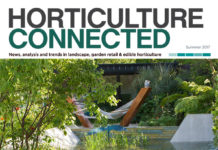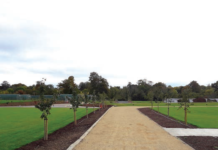Tara McCarthy, Bord Bia’s CEO, shared her ambitions for the Irish horticulture sector with the readers of Horticulture Connected when I caught up with her recently
STRATEGIC INSIGHTHaving spent 20 years at the heart of Ireland’s food and drink industry working as a senior manager in Bord Bia’s consumer foods division, as a director of the food and beverage sector, and then CEO of Bord Iascaigh Mhara, there are few people who can claim to have her knowledge and insight. In this interview, Tara sets out the opportunities and challenges facing the industry and how Bord Bia is adapting to them. |
Where do you see the key opportunities for Irish horticulture over the next decade?
The ambition for the horticulture industry is clearly set out and endorsed by the sector in FoodWise 2025. The target is to achieve an output valued at €500m by 2025. It is an ambitious target and will require all stakeholders in the industry, including Bord Bia, to play their parts to realise it.
Many industries would look enviously at horticulture in terms of the many positive attributes that it has in its favour, particularly when you look at where the opportunities and challenges lie in areas such as economic activity, obesity, and sustainability.
Obesity is a growing problem for first world countries including Ireland. The recommendation from health professionals is to follow a balanced diet with seven portions of fruit and vegetables daily at its core. As Ireland is below these recommended levels, we have an opportunity to increase fresh produce consumption. We are exploring promotional options with the fresh produce sector at the moment to deliver a stronger message to consumers and ultimately increase our intake levels.
Locally grown and sustainably produced food increasingly has a resonance with today’s consumer. We have seen from our own research, particularly when it comes to people ’s understanding of the Bord Bia Quality Mark, the positive influence it has on purchasing decisions. On top of this, we are seeing a growing foodservice sector again after a number of years in recession. Recent Bord Bia research has identified a wholesale market valued at over €390m for fresh produce where operators are increasingly seeking local suppliers.
A recovering economy is a good news for amenity horticulture with both domestic and commercial developments coming on stream helping to build demand for plants, landscape design and construction services. We know that a rise in consumer confidence translates to an increase in gardening spend. This is evident in our most recent market study which has seen the gardening market recovering more with every year. The growing demand for a cleaner, more sustainable and environmentally friendly environment for us to live and work in will create opportunities through the use of more plants and attractively designed spaces. Promotional activity focused on gardening, like the industry’s Gromór campaign, will help to drive and harness this trend.
On the export side, despite various challenges, amenity exports have reached a value of over €17m, which is a commendable performance in the context of Brexit when the UK is the key market. We will work and support exporters to build on these achievements and opportunities to grow them.
Following from the last question, what do you understand to be the key challenges it faces?
Similar to other sectors, there are many challenges impacting the whole horticulture industry at both a business and a market level.
Examples of these include the limited scale of operation, availability of labour, input and business costs and the threat from imported product. Attracting new and younger talent into the industry is also of major concern. The domestic market is very competitive while in our key export market, Brexit is a challenge with much uncertainty surrounding it, particularly the short-term concerns with currency movements.
From the outside looking in, there appear to be significant changes happening in Bord Bia; can you outline the key changes you are making in relation to the horticulture division?
The industry is constantly adapting to the many challenges and opportunities in the current trading environment and Bord Bia, as the marketing and promotion arm of the Irish food, drink and horticulture industry, must ensure that our services to producers and customers are fit for purpose.
Following a review, we concluded that our existing strategy is robust. It concentrates on developing our routes to market for producers, brand communications and promotion, the evolution of the Origin Green sustainability programme, attracting talent to the industry and investing in market insight. The changes you mention are primarily in aligning our teams under these strategic pillars to allow us to deliver our supports effectively where they are most needed and where they will deliver the best outcomes.
Horticulture continues to be a key focus for Bord Bia with its own horticulture board on which sit industry representatives from both amenity and edible horticulture. There are also two horticulture representatives on the main board who ensure the voice of the horticulture industry is clearly communicated.
As part of the team restructure, we have created a new horticulture and meat division. As before, there are dedicated sector managers with specific responsibility for horticulture. In bringing the two sectors under the one division, we are building expertise and synergies across a range of areas including;
- EU funded promotions that cover both categories where significant funds can be secured to implement promotional campaigns;
- developing lean initiatives which we are currently running in both the horticulture and meat sectors;
- investing in consumer insights which provide guidance on trends in the future and where new opportunities exist;
- and building industry participation at Bloom across our food and horticulture industry to underpin its viability in the future.
In addition, Bloom is now part of the marketing department allowing us to strengthen and amplify its horticulture message. While horticulture content is the core of the event, Bloom is supported by all divisions within the organisation to make it a success.
What are your thoughts on fears expressed to me that Bord Bia is undergoing a corporate rationalisation process and that the great work achieved through the efforts of individuals and the nuance of interpersonal relationships is being sacrificed?
I can understand fears may exist when these changes occur particularly where my colleagues have been deeply involved with the industry over many years. We still have the core horticulture team in place in the organisation involved with the industry. We do not wish those relationships to be lost and I expect that our new way of working will allay these fears. The changes are being made with a view to improving how we work as an organisation and deliver for the horticulture industry. We are, of course, open to feedback from the industry so we invite them to get in touch.
One of the key influences Bord Bia has had on the sector is the Quality Assurance programmes. What are your plans for them for the future?
Quality assurance has been a key activity for Bord Bia across food and horticulture sectors for many years. The Amenity Quality Assurance programme will continue to operate as one of our accredited schemes with participants permitted to use the Bord Bia Quality Mark on plants. Bord Bia and the scheme’s technical industry committee will begin to explore the scheme’s evolution under Origin Green, the sustainability development programme, through the addition of sustainability-related criteria. The Landscape Quality Assurance programme, which has operated for a number of years, is currently being reviewed as to its next stage of development and how membership can be built going forward. All of these processes will include feedback and discussion with the industry.
Bloom in the Park is considered to have been the most significant positive contribution to raising the profile of Irish horticulture at both home and abroad. Can you outline how you will build on the momentum created by the show?
Our Bloom festival has been a huge success for both Bord Bia and the industry. It has been a collaborative effort over the years with its success built on the significant input and support of the horticulture industry. We are already busy planning for Bloom this year with the show garden content looking very exciting again. We are aware that we must continue to develop the event to keep it fresh and engaging for our loyal visitors. We are now at the beginning of developing a strategy for Bloom and where we would like to see the event in five years’ time, to build on its success to date and what do we need to do in partnership with the industry to get there. We know from our research around Bloom, that outside of the 120,000 people who visit the show, the publicity generated also considerably impacts on one-third of the wider population who are then influenced to engage in the gardening activity. The aim is to build on this momentum and continue to get this influence to ripple beyond the show itself.
The old maxim, if it can’t be counted it doesn’t count, has always undermined Irish horticulture. Many of the most valuable benefits of horticulture are notoriously difficult to pin down. For example, access to quality parks can reduce incidents of antisocial behaviour, decrease obesity and heart disease and increase rents for buildings. The wider cost saving are enormous but tricky to fix. How do you think we can better articulate this?
Horticulture is all around us and impacts us every day of our lives from the food we eat to the environment we live in, and positive impacts our health and wellbeing. While people may be aware of these aspects, they may not necessarily attribute them to the horticulture industry and indeed can take them for granted. That is a challenge for all of us who have an interest in the industry to identify how we amplify the message and benefits of the industry. There are many industry associations that we provide support to that play a very important role here, including the recently formed Horticulture Industry Forum which includes representation from all sides. Bloom also provides a high profile communications platform for the industry to promote itself and the benefits it provides.
Horticultural exports have remained stubbornly resistant to all manner of initiative and support. How would you like to see this addressed?
Last year, horticulture exports were valued at €108m, dominated by mushroom exports worth €91m and amenity exports at €17m. When one considers that the key market for the majority of these exports was the UK, this was a robust performance overall in the context of Brexit and currency movements. Bord Bia is currently collaborating with the mushroom industry on a new three year EU and industry promotional campaign for mushrooms in the UK and Ireland to help sustain and increase the current share of the market. The mushroom industry has been successful in using innovation, such as Vitamin D mushrooms, to secure and build the market in the UK. Similarly, there are opportunities to grow exports in the amenity sector and we are currently reviewing our Amenity Export programme to explore how we can further support those businesses.
You have the ear of the entire sector. What advice do you have for them?
Bord Bia and I are very committed to the horticulture industry and will continue to work closely with all sectors across our programmes throughout the year.
We see our role as a collaborative one working in partnership with the industry stakeholders and businesses as well the Department of Agriculture, Food and the Marine and other state agencies. There is substantial potential within the industry and I am keen that Bord Bia will play its role fully in helping the industry to realise this. ✽





